Final report for LS16-274
Project Information
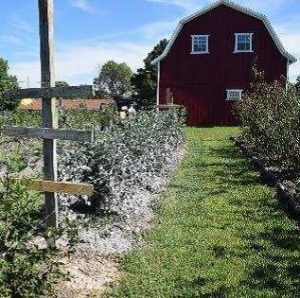
Blackberries are an important fruit crop in Arkansas. Although the majority of varieties that are grown are traditional floricane-fruiting varieties, there is an interest in using primocane-fruiting types to provide berries at a time of year (late summer, early fall) when market prices are at a peak. Unfortunately, there is little information available on managing diseases and insect pests on plants that are fruiting at this time of year. In addition, high late summer temperatures can have a negative impact on primocane-produced fruit production and quality. The use of mineral particle films such as kaolin clay (Surround WP®) to lower leaf temperatures and protect plants from solar injury has been suggested as a way to enhance primocane fruit production. Experiments will be established on two commercial farms in northern and central Arkansas, (Sta-N-Step Farm near Fayetteville, AR, and Gillam Farms of Arkansas, near Judsonia, AR, respectively) and in eastern Texas to evaluate the effects of mineral particle film applications during the late season on blackberry production and on arthropod pests and diseases.
We have had a successful first year in our project.
Gillam Farms already had 2 year old established Prime Ark 45 primocane fruiting blackberries in production. However, Sta-N-Step planted 100 Prime Ark Traveler blackberries on April 22 and Moss Springs Farm planted 100 Prime Ark traveler plants on May 6, 2016. Drip irrigation was installed and landscape fabric was established on both sides of the row to help with soil moisture and weed management. Plants were allowed to grow during the summer (Fig. 3). A trellis system was installed in the fall on each row (Fig. 4). Plants were pruned as needed in January, 2017 to retain 5-6 healthy floricanes to ensure good development of the fall (2017) and 2018 primocane crop. A delayed dormant application of Sulforix (2% solution) was applied to both IPM treatments (IPM with and without Surround) in February. The plots will be fertilized according to soil test recommendations in April, 2017.
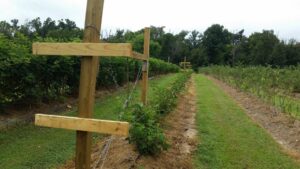
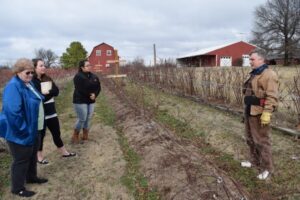

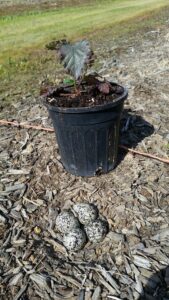
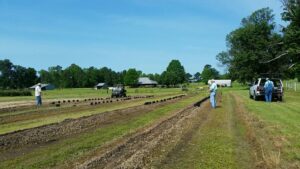
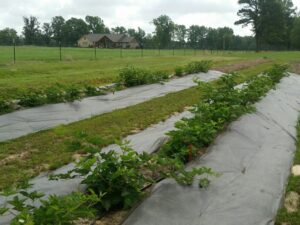
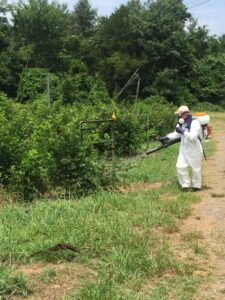

Project objectives
- To demonstrate the importance of primocane-fruiting blackberries in commercial horticulture operations as a way to extend harvest in the fall when market prices are at peak.
- To demonstrate that high late summer temperatures in the southeastern states can be managed with mineral particle films (kaolinite) sprays.
- To determine if mineral particle film sprays can provide protection from various insects and diseases.
Cooperators
- Sherri Sanders (PI), White County Extension Agent, Searcy, AR, involved in overall project coordination, visited participating farmers, and attended area, state, and national meetings to disseminate information; Sherri supervised: Lewis Western, farm labor, and Misty Watkins, trap runner
- Donn T. Johnson (Co-PI), Professor of Department of Entomology, University of Arkansas-Fayetteville, AR, coordinated weather monitoring, pest monitoring and pest management decision-making at all three participating grower plantings. This included placement and downloading of temperature logger data by treatment; sampling to estimate densities of insects and mites by treatment; applying Surround to whitewash plants and help growers decide need and to apply insecticide or fungicide applications by treatment plot; to coordinate and assist with harvest and summarize yields by treatment; and input data, conduct data analyses of temperatures, rainfall, pest densities, and damage by treatment; Donn supervised:
- Barbara Lewis (Program Associate), Jessica LeFors (Masters graduate student), Lizabeth Herrera (Masters graduate student), Rosalee Knipps (Masters graduate student), Anna Mays (hourly), Katherine Massiel Del Cid Palma (hourly), Carmen Bugher (Service Assistant I), Laura Teague (Service Assistant I)
- John Clark, Distinguished Professor of Horticulture, University of Arkansas-Fayetteville, AR, was interviewed on video where he described the history of developing primocane-fruiting blackberry cultivars, recommended production practices and future research needs.
- Craig Rothrock (Co-PI), Professor of Plant Pathology, University of Arkansas-Fayetteville, AR, evaluated blackberry disease in three participating blackberry plantings until he retired in August 2017.
- Terry Kirkpatrick (Co-PI), Professor of Plant Pathology/Extension Plant Pathologist, University of Arkansas, Hope, AR, directed general plot oversight at Moss Berry Farms and took over assessing level of blackberry diseases by treatment in all three farms; Terry supervised:
- John David Barham (Program Associate), Tammy Hickey (Service Assistant II)
- Jennie Popp (Co-PI), Professor of Agricultural Economics and Agribusiness and Area Director, Division of Agriculture Center for Agricultural and Rural Sustainability, University of Arkansas-Fayetteville, AR, directed revision of existing interactive sustainable blackberry budget to include all management practices used on these participating farms, analyzed all data and developed enterprise production budgets for each of the three farms; Jennie supervised:
- Leah A. English (Research Program Associate)
- Karen Ballard (Evaluation), Professor of Program and Staff Development of Cooperative Extension, University of Arkansas-Little Rock, AR, Coordinated communications strategy to include project branding for all communications products, project team training, and producer of Virtual Field Trip; Coordination of overall project evaluation including team training related to data collection and reporting protocols, monthly management of analytics, oversight and evaluation of reach and effectiveness of outreach methods, bi-monthly facilitation of project process improvement communications to inform and improve project management and outreach; she supervised:
- Amanda McWhirt <[email protected]>
- Jackie Lee <[email protected]>
- Leah Wasson <[email protected]> (Technical Assistant I in Office of Information Technology)
- Mary Poling <[email protected]>
- Kerry Rodtnick <[email protected]>
- Julie Robinson <[email protected]>
- Ricky Blair <[email protected]>
- Nick Kordsmeier <[email protected]>
- Mary Hightower <[email protected]>
- Sam Boyster <[email protected]>
- Vonda Nutt <[email protected]>
Research:
Materials and methods: process involved in conducting the project and the logic behind the choices you made.
Objective 1. To demonstrate the importance of primocane-fruiting blackberries in commercial horticulture operations as a way to extend harvest in the fall when market prices are at peak.
Methods: Three farms (Gillam near Searcy, AR, Sta-N-Step near Tontitown, AR and Moss Springs in New Boston, TX) will plant and/or manage primocane-fruiting blackberry plants spaced 0.7 m apart. Plot set up, treatment application and data collection will be supervised by Sanders at Gillam Farm (Searcy, AR), Kirkpatrick at Moss Springs (New Boston, TX), and Johnson at Sta-N-Step (near Tontitown, AR).
At each planting, treatments were a randomized complete block design (four replications). These plants were trickle irrigated as needed. Treatment plots (listed under objective 2) each consisted of five to six individual plants arranged in a randomized complete block design (four replicates). In 2016 near Searcy, AR, a seven-year-old Prime-Ark® 45 primocane-fruiting blackberry planting had four, 30 m (100 ft) rows (blocks) set aside for this study. On 22 April 2016 near Tontitown, AR, 100 Prime-Ark® Traveler primocane-fruiting blackberry plants were planted in a 91 m (300 ft) long row and divided into four blocks. In April 2016 in New Boston, TX, 100 Prime-Ark® Traveler primocane-fruiting blackberry plants were planted in each of four 23 m (75 ft) long rows. After one year of growth in 2017, fruit were harvested by treatment plot twice weekly first from floricanes and later from primocanes at Tontitown and New Boston.
Application dates for Surround mineral particle film (kaolin clay) are listed in Table 1. These applications were made to whitewash the canopy in hopes of lowering the canopy temperature which may affect yield and prevent damage by insects such as spotted wing drosophila and Japanese beetles. Surround was also applied to whitewash emerging green terminals to prevent broad mite outbreaks. Only rains exceeding 0.25” rinsed Surround whitewash off blackberry canopy requiring re-application to maintain whitewash appearance (Table 2). In 2018, the New Boston, TX planting was not whitewashed with Surround because the grower did not want to commit extra labor to washing off the white residue from harvested berries. In 2018, Surround was applied to plants up to July 23 in Searcy, AR and up to June 18 (first green berry) near Tontitown, AR to minimize white residue on harvested fruit.
In 2018, plantings near Tontitown and New Boston had all floricanes pruned off at ground by bud break, removed from planting and fruit on primocanes harvested twice weekly. The grower at New Boston tipped vines in April, and pruned and tied canes to trellis on 22 May, 19 June and 22 Aug. From 18 June until early-July near Tontitown, the grower tipped emerging primocanes at height of 0.6 to 0.9 m (2 to 3 ft), tipped laterals at 0.5 m (1.5 ft) length and thinned each plant to 7 to 10 strong primocanes. The planting at Searcy was not harvested due to on-going sale of the property.
Table 1. Dates of applications of Surround mineral particle film to whitewash blackberry plants in Arkansas and Texas.
|
Searcy, AR |
Tontitown, AR |
New Boston, TX |
|||
|
2017 |
2018 |
2017 |
2018a |
2017 |
2018 |
|
May 31 |
May 25 |
|
May 10, 17, 24 |
|
None |
|
June 17, 22, 27 |
June 11, 25 |
June 8, 18, 27 |
June 1, 18 |
|
applied |
|
July 8, 14, 25 |
July 10, 23 |
July 1, 22 Aug. 3, 10, 17 |
|
July 17, 31 Aug. 8, 15 |
|
a Surround applied up to first green berry on primocanes in late-June to prevent white residue on harvested berries.
Table 2. Rain gauge records of rainfall for Tontitown, AR where a rain exceeding 0.25” would rinse off the Surround mineral particle film whitewash from the blackberry canopy and require re-application.
|
|
Rain (inches) |
|
|
Date |
2017 |
2018 |
|
21 May |
|
0.9 |
|
16 June |
|
0.25 |
|
18 June |
1.8 |
1.3” |
|
30 June |
0.8 |
|
|
8 July |
0.5 |
|
|
16 July |
|
0.6 |
|
17 July |
|
0.9 |
|
18 July |
|
0.4 |
|
21 July |
|
0.7 |
|
7 Aug. |
|
0.5 |
|
12 Aug. |
1.26 |
|
|
12-13 Aug. |
|
0.83 |
|
13 Aug. |
0.43 |
|
|
14-15 Aug. |
0.39 |
0.95 |
|
15-16 Aug. |
1.7 |
|
|
17 Aug. |
|
1.5 |
|
19 Aug. |
|
0.3 |
|
30 Aug. |
|
0.6 |
|
7 Sep. |
|
0.5 |
|
20 Sep |
|
1.5 |
Results:
On 19 January 2017, the Tontitown grower was videotaped as he demonstrated winter pruning these 9-month old blackberry plants to retain four or five of the strongest floricanes (Link: https://www.uaex.edu/farm-ranch/crops-commercial-horticulture/sare-blog/sta-n-step-farm.aspx ). On 15 Aug. 2018, the project team produced a 59 min. Virtual Field Trip titled, Fall Producing Blackberry Production System (Link: https://www.youtube.com/watch?v=TZnuW-KA5CQ&t=260s) at the Sta-N-Step Berry Farm near Tontitown, AR.
In 2017 at New Boston, TX, the blackberry harvest totaled 96.7 lbs of berries from floricanes from 15 May to 12 June and 20.6 lbs of berries from primocanes from 29 July to 9 August (Table 3). In comparison, near Tontitown, AR, blackberry harvest totaled 13.5 lbs of berries from floricanes from 15 May to 12 June and 5.4 lbs of berries from primocanes from 29 July to 14 September (Table 4). There were significant differences in mean yields with the Surround only treatment being less than the Surround + Insecticide treatment on four dates at New Boston, TX (Table 2). The two dates with differences in Tontitwon, AR had the Surround plots yielding more berries than the insecticide treated plots (Table 4). Not sure why there were discrepancies between sites.
In 2018, the floricanes had been removed before bud break so harvest was from primocanes only. A total of 14 lbs and 11.7 lbs of berries, respectively, were harvested from the five plant plots of 2-yr-old Prime-Ark® Traveler blackberries at New Boston, TX (from 5 to 30 July) (Table 5) and Tontitown, AR (15 June to 14 September) (Table 6). Mean season total harvest weights per five-plant plot ranged from 2.5 lbs in untreated plots to 3.5 lbs. in plots whitewashed with Surround in May and June prior to green fruit development. There were no significant (P>0.05) differences in treatment mean yields in either location. This may be attributed to the fact that no Surround was applied to whitewash plants at the New Boston farm and the planting near Tontitown had five Surround applications from 10 May to 18 June when sprays ended at first green berry compared to applications in July and August 2017 (Table 1). This earlier whitewash cutoff date was to minimize white residue on harvested berries.
Table 3. Biweekly and season mean total harvest yields in lbs (±SE) per treatment plot of five Prime-Ark® Traveler blackberry plants during two cane production periods (F = floricane = earlier; P = primocane = later) in each of four treatment plots (n=4): Surround whitewash; Surround whitewash + insecticide; insecticide; or untreated plants. The F and P values were derived from log10(x+0.1) transformed data from New Boston, TX (2017).
|
|
|
Berry yield (lbs) |
|
|
||||
|
Date |
Cane type |
Sur |
Sur + Cide |
Cide |
Untrt |
Row total |
F3,3 |
P>F |
|
15-May |
F |
0.2±0.02 |
0.2±0.05 |
0.2±0.02 |
0.2±0.04 |
0.7 |
0.82 |
0.5 |
|
17-May |
F |
0.4±0.03 |
0.6±0.09 |
0.5±0.05 |
0.5±0.08 |
2.1 |
1.9 |
0.2 |
|
19-May |
F |
0.8±0.11b |
1.2±0.07a |
0.8±0.02ab |
0.8±0.09b |
3.6 |
4.16 |
0.04* |
|
20-May |
F |
0.5±0.06b |
0.7±0.03a |
0.6±0.02ab |
0.7±0.08ab |
2.5 |
4.82 |
0.03* |
|
22-May |
F |
1.2±0.07b |
1.7±0.1a |
1.2±0.07b |
1.5±0.06ab |
5.6 |
7.27 |
0.009** |
|
23-May |
F |
0.8±0.13 |
1.1±0.09 |
0.8±0.04 |
1.0±0.08 |
3.7 |
1.93 |
0.2 |
|
26-May |
F |
1.9±0.25 |
2.5±0.12 |
2.3±0.22 |
2.1±0.29 |
8.8 |
1.66 |
0.24 |
|
28-May |
F |
2.8±0.14 |
2.9±0.14 |
3.0±0.38 |
2.4±0.29 |
11.0 |
1.84 |
0.21 |
|
30-May |
F |
2.8±0.18ab |
2.4±0.22ab |
2.2±0.11b |
3.1±0.11a |
10.4 |
4.35 |
0.04* |
|
2-Jun |
F |
3.1±0.36 |
3.8±0.47 |
3.5±0.19 |
4.1±0.49 |
14.6 |
1.13 |
0.4 |
|
3-Jun |
F |
1.3±0.16 |
1.6±0.31 |
1.7±0.13 |
1.5±0.05 |
6.1 |
0.63 |
0.6 |
|
6-Jun |
F |
2.1±0.19 |
2.6±0.39 |
3.0±0.24 |
3.2±0.29 |
10.9 |
3.14 |
0.08 |
|
8-Jun |
F |
2.0±0.22 |
2.5±0.56 |
2.7±0.44 |
2.9±0.26 |
10.1 |
1.16 |
0.38 |
|
12-Jun |
F |
1.3±0.24 |
1.6±0.53 |
1.6±0.31 |
2.1±0.37 |
6.7 |
0.68 |
0.6 |
|
|
F total |
21.1 |
25.2 |
24.3 |
26.1 |
96.7 |
|
|
|
30-Jul |
P |
1.9±0.27b |
2.4±0.19a |
2.5±0.21a |
2.1±0.12a |
8.8 |
6.57 |
0.01** |
|
1-Aug |
P |
0.9±0.22b |
1.3±0.23ab |
1.6±0.08a |
1.9±0.2a |
5.6 |
11.33 |
0.002** |
|
7-Aug |
P |
1.3±0.29 |
2.0±0.33 |
1.7±0.1 |
1.4±0.17 |
6.3 |
2.2 |
0.16 |
|
|
P total |
4.1 |
5.6 |
5.7 |
5.4 |
20.7 |
|
|
Means in a row with followed by no letters or followed by the same letter are not significantly different (Tukey, P > 0.05)
* P < 0.05; ** P < 0.01
Table 4. Biweekly and season mean total harvest yields in lbs (±SE) per treatment plot of five Prime-Ark® Traveler blackberry plants during two cane production periods (F = floricane = earlier; P = primocane = later). Treatment plots (n=4) included: Sur = Surround whitewash; Sur+Cide = Surround whitewash + insecticide; Cide = insecticide; or Untrt = untreated plants. The F and P values were derived from log10(x+0.1) transformed data from Tontitown, AR (2017)
|
|
|
Berry yield (lbs) |
|
|
||||
|
Date |
Cane type |
Sur |
Sur + Cide |
Cide |
Untrt |
Row total |
F3,3 |
P > F |
|
15-Jun |
F |
1.5±0.88 |
0.9±0.32 |
1.2±0.5 |
1.4±0.46 |
5.03 |
0.55 |
0.7 |
|
22-Jun |
F |
1.2±0.62 |
0.5±0.11 |
0.8±0.26 |
0.9±0.28 |
3.46 |
0.99 |
0.4 |
|
27-Jun |
F |
0.5±0.1a |
0.3±0.04a |
0.2±0.05b |
0.3±0.05ab |
1.34 |
8.84 |
0.005** |
|
29-Jun |
F |
0.5±0.12 |
0.3±0.06 |
0.4±0.11 |
0.4±0.08 |
1.67 |
1.79 |
0.2 |
|
6-Jul |
F |
0.3±0.05 |
0.2±0.03 |
0.3±0.05 |
0.2±0.02 |
1.05 |
0.96 |
0.5 |
|
13-Jul |
F |
0.2±0.07 |
0.1±0.06 |
0.1±0.04 |
0.0±0.03 |
0.5 |
0.97 |
0.4 |
|
20-Jul |
F |
0.2±0.06 |
0.1±0.0 |
0.1±0.02 |
0.1±0.02 |
0.43 |
2.78 |
0.10 |
|
|
F total |
4.4 |
2.7 |
3.1 |
3.4 |
13.5 |
|
|
|
27-Jul |
P |
0.3±0.03a |
0.2±0.04ab |
0.0±0.02b |
0.1±0.03ab |
0.56 |
6.92 |
0.01* |
|
3-Aug |
P |
0.2±0.09 |
0.2±0.05 |
0.1±0.03 |
0.2±0.05 |
0.64 |
3.17 |
0.08 |
|
10-Aug |
P |
0.2±0.09 |
0.2±0.03 |
0.2±0.06 |
0.2±0.05 |
0.75 |
0.31 |
0.8 |
|
17-Aug |
P |
0.3±0.04 |
0.4±0.08 |
0.2±0.07 |
0.3±0.06 |
1.19 |
1.44 |
0.3 |
|
24-Aug |
P |
0.3±0.12 |
0.4±0.05 |
0.2±0.08 |
0.3±0.06 |
0.99 |
1.97 |
0.19 |
|
31-Aug |
P |
0.3±0.17 |
0.3±0.07 |
0.1±0.02 |
0.1±0.02 |
0.87 |
3.29 |
0.09 |
|
14-Sep |
P |
0.9±0.07 |
0.9±0.03 |
0.14±0.1 |
0.05±0.03 |
0.38 |
0.51 |
0.7 |
|
|
P total |
1.6 |
1.6 |
0.8 |
1.1 |
5.4 |
|
|
Means in a row followed by no letters or followed by the same letter are not significantly different (Tukey, P > 0.05)
* P < 0.05; ** P < 0.01
Table 5. Twice weekly and season mean total harvest yields in lbs from 2-yr-old Prime-Ark® Traveler blackberry primocanes only by four treatment plots (n=4): Sur = Surround whitewash; Sur + Cide =Surround whitewash + insecticide; Cide = insecticide; or Untrt = untreated. There were no significant differences among four treatments (P > 0.05) in New Boston, TX (2018).
|
|
Berry yield (lbs) |
||||
|
Date |
Sur |
Sur+Cide |
Cide |
Untrted |
Row total |
|
5-Jul |
0.3 |
0.3 |
0.4 |
0.4 |
1.3 |
|
8-Jul |
0.7 |
0.8 |
0.8 |
0.9 |
3.1 |
|
10-Jul |
0.5 |
0.7 |
0.7 |
0.7 |
2.6 |
|
12-Jul |
0.6 |
0.5 |
0.6 |
0.6 |
2.2 |
|
14-Jul |
0.6 |
0.6 |
0.5 |
0.5 |
2.3 |
|
15-Jul |
0.4 |
0.4 |
0.4 |
0.3 |
1.6 |
|
20-Jul |
0.3 |
0.3 |
0.2 |
0.3 |
1.1 |
|
Season total |
3.4 |
3.5 |
3.6 |
3.7 |
14.2 |
Table 6. Biweekly and season harvest total mean yields in lbs ±SE (n=4) from Prime-Ark® Traveler blackberry primocanes only by four treatment plots: Sur = Surround whitewash; Sur + Cide =Surround whitewash + insecticide; Cide = insecticide; or Untrt = untreated. There were no significant differences among four treatments (P > 0.05) in Tontitown, AR (2018).
|
|
Berry yield (lbs) |
||||
|
Date |
Sur |
Sur + Cide |
Cide |
Untrt |
Row total |
|
Jul-30 |
0.06 |
0.09 |
0.05 |
0.07 |
0.3 |
|
Aug-6 |
0.35 |
0.28 |
0.23 |
0.34 |
1.2 |
|
Aug-10 |
0.47 |
0.64 |
0.49 |
0.27 |
1.9 |
|
Aug-14 |
0.45 |
0.54 |
0.33 |
0.33 |
1.7 |
|
Aug-17 |
0.15 |
0.15 |
0.08 |
0.14 |
0.5 |
|
Aug-21 |
0.41 |
0.16 |
0.26 |
0.25 |
1.1 |
|
Aug-24 |
0.21 |
0.13 |
0.14 |
0.11 |
0.6 |
|
Aug-28 |
0.21 |
0.15 |
0.12 |
0.12 |
0.6 |
|
Aug-30 |
0.17 |
0.11 |
0.17 |
0.09 |
0.5 |
|
Sep-4 |
0.39 |
0.19 |
0.3 |
0.25 |
1.1 |
|
Sep-7 |
0.14 |
0.12 |
0.13 |
0.13 |
0.5 |
|
Sep-11 |
0.11 |
0.13 |
0.18 |
0.15 |
0.6 |
|
Sep-14 |
0.07 |
0.07 |
0.04 |
0.05 |
0.2 |
|
Sep-19 |
0.11 |
0.09 |
0.11 |
0.13 |
0.4 |
|
Sep-27 |
0.16 |
0.06 |
0.04 |
0.06 |
0.3 |
|
Oct-4 |
0.06 |
0.01 |
0.04 |
0.03 |
0.2 |
|
Season Total |
3.5 |
2.9 |
2.7 |
2.5 |
11.7 |
Objective 2. To demonstrate that high summer temperatures in the southeastern states can be managed with mineral particle films (kaolinite) sprays.
Canopy treatments include: 1) Sur = Surround® WP kaolin clay mineral particle film only applied weekly or as needed; 2) Sur + PM = Surround + pest management (PM) pesticide applied as needed plus conventional integrated pest management practices; 3) PM = PM treatment only; and 4) Untrt = untreated plants (check). Surround® WP was applied using a Stilh backpack airblast sprayer at a rate of 50 lb/acre to whitewash plants. Whitewash and/or insecticide residues were maintained by re-applying as needed after rains greater than 0.25”.
In 2017, the Tontitown planting had four WatchDog 1000 series loggers (4 replicates) each inside a radiation shield set at 1 m height next to the blackberry planting to record ambient air temperatures. Recordings were made at half hour intervals from May 22 (before first Surround application) to August 31 (end of harvest). Each logger recorded temperatures from two micro sensor gator clipped to underside of separate blackberry leaves at 0.1 m and two at 0.3 m height inside the canopy of each of the four treatment plots (fig. 1). Mean ambient air temperatures were compared to mean temperatures from inside the blackberry canopy whitewashed with either Surround (Sur or Sur + Cide) or a green canopy (Cide and Untrt).
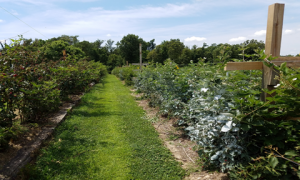


Figure 1. Blackberry canopy whitewashed with Surround mineral particle film (kaolin clay).
The air temperatures (ambient) next to plants were slightly warmer (more degree-days accumulated, base 50°F) than those in the blackberry canopy at 1 or 3 ft heights with or without whitewash of Surround. There was no significant difference between temperatures inside the blackberry canopy on underside of leaf on plants whitewashed with Surround kaolin clay or unsprayed (green) (Fig. 2).
A difference comparison was made of temperatures of ambient air minus underside of leaves whitewashed with Surround for periods of no sun (night from 8pm to 7am) and sun (day = 7am to 8pm) (Fig. 3-5). During the day, the ambient air was frequently greater than the whitewashed canopy by 0 to 6°F (mean of 2°F) compared to 0 to 3°F (mean of 1°F) at night which showed the heating effect of sunlight on air and canopy temperatures.
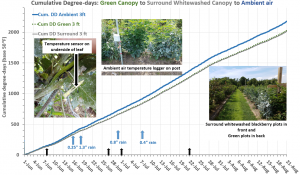

Figure 2. Cumulative degree-days (base 50°F) of ambient air (blue line), leaf inside canopy whitewashed with Surround kaolin clay (gray line) applied on 8, 27 June, and 1, 22 July (black arrows) leaf in untreated green canopies (green line). Rain exceeding 0.5 inches fell on 18, 30 June and 7 to 8 July (blue arrows) near Tontitown, AR (2017).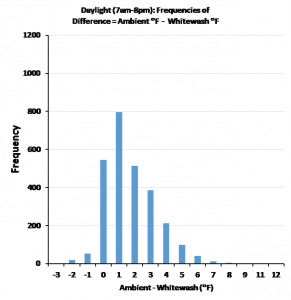
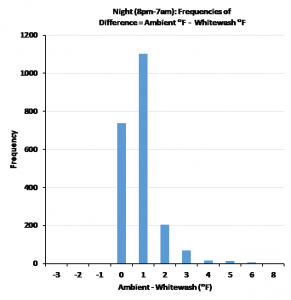


Figure 3. Distributions of frequencies of differences in temperatures of ambient air - Surround whitewashed canopy of Prime-Ark® Traveler blackberry during A) daylight (7am-8pm) and B) night (8pm-7am) near Tontitown, AR (2017)
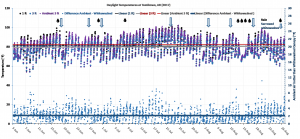

Figure 4. Daylight (7am-8pm) temperatures recorded at ½ hr intervals by WatchDog logger. Left y-axis values are for ambient air temperature in radiation shield at 3 ft height (purple dots, from micro sensors clipped to underside of leaf at 1 ft (black dots) and 3 ft (light blue dots) inside the canopy of Prime-Ark® Traveler blackberries and corresponding colored trend lines. Arrows note dates plants were whitewashed with Surround and tear drops note rainfall >0.25”. Right y-axis values are for lower blue dots and blue trend line are the differences between ambient air – inside Surround whitewashed canopy (Tontitown, AR 2017)
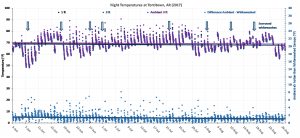

Figure 5. Night (8pm-7am) temperatures recorded at ½ hr intervals by WatchDog logger. Left y-axis values are for ambient air temperature in radiation shield at 3 ft height (purple dots, from micro sensors clipped to underside of leaf at 1 ft (black dots) and 3 ft (light blue dots) inside the canopy of Prime-Ark® Traveler blackberries and corresponding colored trend lines. Right y-axis values are for lower blue dots and blue trend line are the differences between ambient air – inside Surround whitewashed canopy (Tontitown, AR 2017)
Objective 3. To determine if mineral particle film sprays can provide protection from various insects and diseases.
Sanders at Gillam Farm, Kirkpatrick at Moss Springs, and Johnson at Sta-N-Step will monitor treatment plots and decide when growers should apply recommended conventional pest management practices (2015 Midwest Small Fruit and Grape Spray Guide; Anonymous, 2015). These pest management decisions will be made by plot: using biweekly monitoring of baited traps for spotted wing drosophila (SWD) flies, leaves for broad mites and spider mites, fruit clusters for stink bugs, general plant inspection for other insect pests; and record severity ratings for presence of anthracnose, cane blight, rosette, or other diseases. During weekly harvest, all berries per plot will be collected and inspected for presence/severity of anthracnose and grey mold, and note the percentage of berries infested by SWD.
Formulations of fungicides and insecticides and application dates are listed in Table 7. In New Boston, TX, the grower applied Bifenthrin or Ravage (Lambda-cyhalothrin) in 2017 or Malathion in 2018 for stink bugs. Near Tontitown, AR the grower used pto powered custom spray nozzles to apply fungicides to all blackberry plants for anthracnose control in 2017 and in 2018 and applied Imidacloprid for rednecked cane borer control in 2017. In Searcy, AR, a Stihl backpack airblast sprayer was used to apply fungicide to plots 2 (Sur + PM) and 3 (PM). Insecticide sprays against spotted wing drosophila were applied (re-applied after significant rainfall) to treatment plots 2 (Sur + PM) and 3 (PM) in 2017 and in 2018.
Results:
The insecticide applied to treatments 2 and 3 included: Malathion 1, 3 July; Mustang Maxx on 12 June, 19 July, 26 August, 11, 22 September; and Delegate on 1, 10 August. These insecticides were applied to prevent damage to flowers by Japanese beetles (JB), damage to ripening berries by green June beetles (GJB) in July and SWD from early-June through 4 October. In and around the blackberry planting, there were low, sub economic densities of JB adults in June and July (Table 8) and GJB adults in July (Table 9). The GJB adults were mass trapped using 17 bottle traps placed 5m apart on fence in perimeter and baited with paper wicked pouched dispensing 50% isopropanol that captured 4,907 GJB adults. In an adjacent Natchez blackberry row there were ripe berries being fed on by GJB adults even after weekly applications of Mustang Maxx. Johnson is still analyzing SWD fly counts that emerged from fruit harvested from 7 September to 4 October and tabulating data from Searcy, AR and New Boston, TX.
Table 7. Dates of pest management applications of fungicides and insecticides to blackberry plants in Arkansas and Texas.
|
|
Searcy, AR |
Tontitown, AR |
New Boston, TX |
|||
|
|
2017 |
2018 |
2017 |
2018 |
2017 |
2018 |
|
Fungicides |
|
|
|
|
|
|
|
Lime Sulfur or SulfurX |
|
|
Mar. 3 |
Feb. 28 |
Mar. 15 |
|
|
Pristine |
May 31 June 17 June 22 June 27 July 8, 14, 24 |
May 25 June 11, 25 July 10, 23 |
Apr. 27 Aug. 17 |
Apr. 24 |
|
|
|
Captan |
|
|
Apr. 7 May 15 June 18 |
May 8 |
|
|
|
Abound |
|
|
May 25 June 6, 21 |
|
|
|
|
Insecticides |
|
|
|
|
|
|
|
Imidacloprida |
|
|
May 3 |
|
|
|
|
Ravageb |
|
|
|
|
May 7, 24 |
|
|
Malathionc |
|
|
June 22 |
July 1, 3 |
|
May 24 |
|
Mustang Maxxc or Bifenthrinbc |
|
|
May 25 June 6 July 8, 18 Aug. 24, 31 |
June 12 July 8, 19 Aug. 1, 10, 26 Sep. 11, 22 |
17 July |
|
|
Delegate c |
|
|
Aug. 7, 15 Sep. 10, 20 |
Aug. 1, 10 |
|
|
|
Entrust c |
|
|
July 24 Aug. 1 |
|
|
|
a Rednecked cane borer
b Stink bug
c Spotted wing drosophila
Table 8. Mean numbers of Japanese beetles captured in baited yellow funnel traps adjacent to two blackberry plantings in Northwest Arkansas (2018).
|
Date |
Tontitown, AR |
Date |
Fayetteville, AR |
|
15-Jun |
290 |
19-Jun |
975 |
|
18-Jun |
389 |
22-Jun |
888 |
|
25-Jun |
238 |
25-Jun |
388 |
|
27-Jun |
969 |
27-Jun |
1,388 |
|
2-Jul |
1,881 |
2-Jul |
1,831 |
|
4-Jul |
3,475 |
5-Jul |
350 |
|
10-Jul |
2,038 |
|
|
|
16-Jul |
2,231 |
|
|
|
23-Jul |
2,656 |
25-Jul |
4,463 |
|
30-Jul |
3,144 |
1-Aug |
800 |
|
6-Aug |
919 |
|
|
|
13-Aug |
300 |
14-Aug |
369 |
Table 9. Mean per trap and total numbers of green June beetles captured in 17 baited (66% isopropanol) bottle traps set at 2 foot height on fence adjacent to blackberry planting near Tontitown, AR (2018).
|
Date |
Mean/trap |
Total |
|
16-Jul |
67 |
1068 |
|
23-Jul |
127 |
2152 |
|
27-Jul |
49 |
826 |
|
30-Jul |
26 |
435 |
|
9-Aug |
20 |
348 |
|
16-Aug |
5 |
78 |
Number of farmers who participated in the research (3):
- Les Dozier, participating blackberry grower near Tontitown, AR
- Jeremy Gillam, Doug Gillam and Ritter Farm participating blackberry grower in Judsonia, AR
- Eric Lum, participating blackberry grower in New Boston, TX
Cooperators
- - Producer
- - Producer (Researcher)
- - Producer
Research
Education
Educational and Outreach Activities
Dissemination of research and production information for management of a fall producing blackberry system was delivered through a diverse digital communication strategy utilizing:
1. research project branding,
2. development of branded educational messages with targeted messages for digital platforms,
3. creation and curation of original web content ( producer resource pages and a blog),
4. repurposing and archiving key producer production resources in a digital format that increased user accessibility through an improved web interface,
5. Facebook,
6. Twitter,
7. Constant Contact e-newsletters,
8. re-purposed communication products on partner websites,
9. the 2018 Virtual Field Trip broadcast with close-captioning, and
10. Editing and posting the Virtual Field Trip with corresponding script re-posted on You-Tube and marketed to target audience including registrants who did not attend.
Educational & Outreach Activities
Participation Summary:
Educational and Outreach Activities
Dissemination of research and production information for management of a fall producing blackberry system was delivered through a diverse digital communication strategy utilizing:
1. research project branding,
2. development of branded educational messages with targeted messages for digital platforms,
3. creation and curation of original web content ( producer resource pages and a blog),
4. repurposing and archiving key producer production resources in a digital format that increased user accessibility through an improved web interface,
5. Facebook,
6. Twitter,
7. Constant Contact e-newsletters,
8. re-purposed communication products on partner websites,
9. the 2018 Virtual Field Trip broadcast with close-captioning, and
10. Editing and posting the Virtual Field Trip with corresponding script re-posted on You-Tube and marketed to target audience including registrants who did not attend.
Learning Outcomes
The Virtual Field Trip demographics included identification at the time of registration of participants as “small fruit producers,” with a secondary evaluation question of “my primary occupation.” At registration 127 registrants identified themselves as small fruit producers. Live broadcast participants included 103 “small fruit producers,” with 33 identifying small fruit production as their “primary” occupation.
Education was delivered during this project through a multi-platform blended learning strategy for adult learners. A dedicated web and blog landing page was created for this project, with over 250 posted and/or linked peer-reviewed educational resources organized and curated for this project’s target audience.
Original contemporary content was authored and posted regularly in the blog by project research team members, which was featured on the project landing page (uaex.edu website). Curated educational resources accessed by clientele included information related to each farm research site, the goals and scope of this research, collaborators, risk management tools, and production resources for blackberry producers. Between 2017-2018, 2,818 the SSARE Blackberry Research Blog recorded 2,818 visitors to this page.
An indicator of participant engagement in live/virtual educational programs is interaction. VFT participants submitted 126 comments and questions during the live broadcast, which is considered a high level of participant engagement for a program with 279 participants.
Educational outcomes were measured for participants of the Virtual Field Trip related to knowledge gained, attitudes and intention to adopt technology/new practices utilizing a Qualtrics online survey. The evaluation was promoted during the broadcast and the survey link was disseminated to broadcast participants upon completion of the educational session. Survey design included question logic targeted to small-fruit producers with targeted questions related to farmer adoption and further dissemination.
VFT survey respondents included 75 non-producer respondents and 18 respondents identifying themselves as blackberry producers.
Ninety-six percent (96%/70) of overall survey respondents reported that they planned to share educational information learned through the Virtual field trip.
Seventy-eight percent (78%/14) of producer respondents reports that they planned to adopt practices shared through the Virtual Field Trip. Twenty-two percent (22%/4) of producers responded that they might adopt practices shared. No respondents indicated that that would not adopt practices shared.An open-ended question was provided to respondents for additional suggestions for improvement and future Virtual Field Trips. Respondents provided a wide range of qualitative feedback including:
• More actual field/farm examples and methods (pruning the canes/measuring the percentage of shade)
• More conversation with growers
• More time/fewer speakers on panel
• This was a very professional and informative presentation
• Hope you do more of them
• The most comprehensive live-feed event I have ever been a part of (there is nothing I can think of to improve)
• More information for small producer control of pest/disease
• Video-streaming was a bit choppy for me (bandwidth)
• This was my first VFT and I enjoyed it
• Audio was a little hard to hear in the field
• This was great-I’m researching for a community orchard
• Outdoor lights seems a bit blurred/interior shots sharp and clear
• Keep adding more topics and demonstrations
• Should be longer/felt rushed
• Thought the presentation was excellent and very informative
• Perhaps easy access to Q & A without waiting on the re-broadcast of the webinar
• Very interesting
• I want to start growing blackberries and many of my questions were answered and I got to see how the blackberries should be managed. I also got the names and sources of types of berries to grow
• The economics took up a lot of time that might not have been pertinent to a large part of the audience. You might consider a separate economics webinar immediately following the first.
• You all did a great job
• Being in the blackberries would have been great but the reasoning was understandable (rain/flooding at farm)
• Have resource downloadable sheet available
• Excellent production/need to do the same for blueberries and strawberries
• Additional information on pesticide: types and when to use
• Perhaps give a bit more information for the home grower. Still, I gained a lot of useful ideas and information
• Please send me access to recording.
Project Outcomes
Impacts
Les Dozier prepared a 300 ft raised bed row and installed drip irrigation by 22 April 2016 when he planted 100 Prime-Ark® Traveler blackberry plants 2 ft apart. By 18 August, this row of blackberries were healthy, averaged 1 ft tall and Les had installed a trellis with two wires at 1ft and 4 ft heights . On 19 January 2017, Les discussed and was videotaped as he demonstrated and described how to winter prune these 9 month-old primocane-fruiting blackberry plants to retain four or five healthy floricanes to ensure development of 2017 and 2018 primocanes . The goal is to obtain mature plants by summer 2018.
Canopy versus Ambient Temperatures: On 6 and 12 September 2016, each of four WatchDog 1650 loggers (4 replicates) in radiation shield records data at ½ hr intervals of ambient air temperature and %RH and temperatures from 2 to 4 microsensors pinned to underside of leaf in canopy interior in each of 4, 10 ft blackberry plots in each of two fields: 180 ft row of three 60 ft plots of mature primocane-fruiting blackberry cultivars (Prime-Ark®45, APF205, or Prime-Ark®Traveler) at the Arkansas Agricultural Research and Extension Center in Fayetteville, AR; and four, 40 ft rows of Prime-Ark® 45 blackberries at Gillam Farm near Searcy. In Fayetteville from 11am to noon on 12 September 2016, two plots in each section were either untreated or whitewashed with Surround WP kaolin clay. At each location, temperatures in canopy interior were 1.2 °F cooler than ambient air temperatures in loggers in radiation shields.
In 2017, one of four treatments will be applied to 10 ft plots including: 1) whitewashing with Surround only; 2) whitewashing with Surround + PM practices as needed; 3) No Surround + PM practices as needed; and 4) untreated (control). One logger will be set at 3ft height just outside canopy of one the four treatment plots to measure ambient air temperature. This logger will record temperatures from its 4 temperature sensors pinned to underside of leaflets in lower canopy interior in that same treatment plot (4 reps. of temperature in each treatment plot). This will be repeated in the other three treatment plots. Treatment plot inner canopy temperatures will be averaged and compared among treatments and the ambient temperatures.
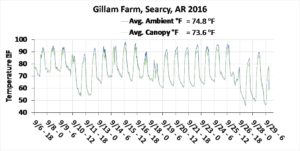
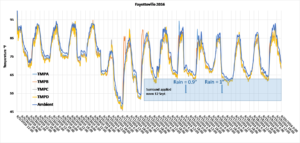
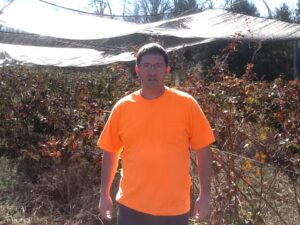
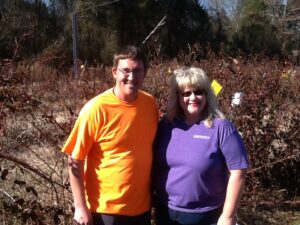
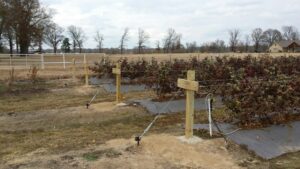
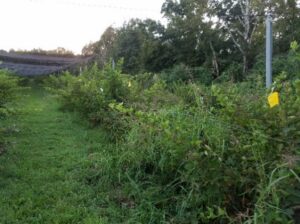
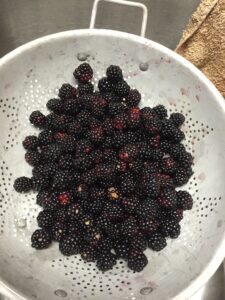
Objective 3 analyzes the economic feasibility of primocane fruiting blackberries. Performing this analysis requires the collection of production and value data from project research partners. To ensure adequate data are collected, initial contact was made with participating farms. During this contact, they were asked to review data collection sheets that were specifically developed for this portion of the project. We will be scheduling meetings with farmers during year two to further discuss their production methods and ensure that values are being properly recorded using the data collection sheets. During year three, we will continue collecting data from producers. Once data collection is complete, we will use these values to update our Interactive Sustainable Blackberry Budget tool and estimate the economic outcome of primocane fruiting blackberry production under various scenarios.
Accomplishments
Twitter site: https://twitter.com/SARE_Blackberry Blackberry Research (@SARE_Blackberry)
Facebook page: https://www.facebook.com/SSAREBlackberry/ SSAREBlackberry
Short url for website: https://uaex.edu/ssareblackberry
Links to all videos on You tube:
Gillam Videos: https://www.youtube.com/watch?v=XRkzHcMcFBM
https://www.youtube.com/watch?v=bT_CuDROtv4
https://www.youtube.com/watch?v=ut55IYUxLRc
https://www.youtube.com/watch?v=cksAsTj53WA
Moss Springs Video:
https://www.youtube.com/watch?v=_IncFCTyOEA
Sta-N-Step Videos:
https://www.youtube.com/watch?v=Kf_VGNVzh6A
Video: Winter pruning blackberry plants produced on 9 January 2017. This recording is available at: https://www.uaex.edu/farm-ranch/crops-commercial-horticulture/sare-blog/sta-n-step-farm.aspx
Video: Virtual Field Trip - Fall Producing Blackberry Production System produced on August 15, 2018. This broadcast featured John Clark, Sherri Sanders and other Division of Agriculture research and extension faculty, including: Terry Kirkpatrick, Donn Johnson, Jennie Popp, Leah English, and fruit producers Les Dozier, Eric Lum and representative from Ritter Agribusiness. Produced and livestreamed from Tontitown, AR and published by the University of Arkansas System Division of Agriculture Department of Communications. This was broadcast internationally to registered sites including Ghana, China, Greenland, the United Kingdom, and to 30 states within the US (with a total of 279 participant locations) including 177 small fruit producers, 114 Master Gardeners, NIFA SSARE federal partners and CES research/extension personnel. The 59 min. video recording is available at: https://www.youtube.com/watch?v=TZnuW-KA5CQ&t=260s
Johnson, D. 2017. Spotted wing drosophila ID and trapping in blackberry. 2017 Arkansas Blackberry School "How To" Video Series. Produced and published by the University of Arkansas System Division of Agriculture Department of Communications. Video available at: https://www.youtube.com/watch?v=-LDfbeIaqng
Educational
Later on 15 August 2018, Dr. Karen Ballard conducted a post evaluation of the team that participants shortly after the live Virtual Field Day on 15 August 2018.
- Karen Ballard <[email protected]>
- Mary Poling <[email protected]>
- Kerry Rodtnick <[email protected]>
- Julie Robinson <[email protected]>
- Sherri Sanders <[email protected]>
- Donn Johnson <[email protected]>
- Terry Kirkpatrick <[email protected]>
- Jennie Popp <[email protected]>
- Leah A. English <[email protected]>
- Ricky Blair <[email protected]>;
- Nick Kordsmeier <[email protected]>
- Les Dozier, Tontitown, AR
- Ritter Agribusiness, Judsonia, AR
- Eric Lum, New Boston, TX
- August 15, 2018 Virtual Field Trip Team
|
Team |
Responsibilities |
|
Karen Ballard |
Assist with Set-Up & Direct Rehearsal |
|
Julie Robinson |
Assist with Set-Up & Provide Technical Support for Content Delivery |
|
Kerry Rodtnick, Ricky Blair, Nick Kordsmeier |
Coordinate Technical Set-Up & Video Production |
|
Mary Poling & Vonda Nutt |
Coordinate ZOOM Production & Interface with Remote Participants |
|
Sherri Sanders and Terry Kirkpatrick |
Masters of Coordination |
|
Jennie Popp & Leah English |
Talk about blackberry economics |
|
Donn Johnson |
Talk about blackberry pest management |
|
Growers: Les Dozier, Eric Lum, Ritter Agribusiness |
Talk about what they learned about primocane production and the use of Surround clay applications |
Impact:
On 15 August 2018, as part of the SSARE project LS16-274, the University of Arkansas Cooperative Extension broadcast a Virtual Field Trip on primocane blackberry production internationally to registered sites including Ghana, China, Greenland, the United Kingdom, and to 30 states within the US. There were 279 participant locations including 177 small fruit producers, 114 Master Gardeners, and NIFA SSARE federal partners and CES research/extension personnel.
Publications:
LeFors, J., D. Johnson, and T. Woodruff. 2017. Acaricidal control of broad mites in blackberry, 2016. Arthropod Management Tests 42(1): <https://doi.org/10.1093/amt/tsx113>.
Lefors, J.A., D.T. Johnson, T. Kirkpatrick, T. Woodruff, and G.J. De Moraes. 2018. A two step centrifugation method with water and sucrose to separate mites from raw extracts of tullgren funnels. Syst. Appl. Acarol.-UK 23(5):860-867.
LeFors, J. 2018. Seasonal phenology, distribution and treatments for Polyphagotarsonemus latus (Banks) on primocane-fruiting blackberries (Rubus L. subgenus rubus) in Arkansas. University of Arkansas, Fayetteville, M.S. thesis.
Herrera, L. 2017. Seasonality and management of spotted wing drosophila on berry crops and wild hosts in Arkansas. University of Arkansas, Fayetteville, M.S. thesis.
Johnson, D., E. Garcia, C. Rom, L. Freeman, SH. Kim, and B. Lewis. 2016. Management of arthropods on blackberries and raspberries in Arkansas USA Acta Hortic. 1133: 437-444. (DOI: 10.17660/ActaHortic.2016.1133.67) http://dx.doi.org/10.17660/ActaHortic.2016.1133.67
Knipps, R. 2018. Spotted wing drosophila (Drosophila suzukii) in Arkansas: wild hosts, winter morphs, and fungal control. University of Arkansas, Fayetteville, M.S. thesis.
Information Products
- Economic Feasibility of Primocane Fruiting blackberries (Article/Newsletter/Blog)
- Virtual Field Trip (Video)
- Multidisciplinary Virtual Field Trip Team Members (Video)
- Communication and Outreach Goals and Performances (Article/Newsletter/Blog, Decision-making Tool, Website)
- Contacts (Article/Newsletter/Blog, Bulletin, Conference/Presentation Material, Course or Curriculum)
- Learning Outcomes (Video)
- Video: Winter pruning blackberry plants produced on 9 January 2017. (Video)
- Spotted wing drosophila ID and trapping in blackberry (Video)
- Management of arthropods on blackberries and raspberries in Arkansas USA Acta Hortic (Peer-reviewed Journal Article)